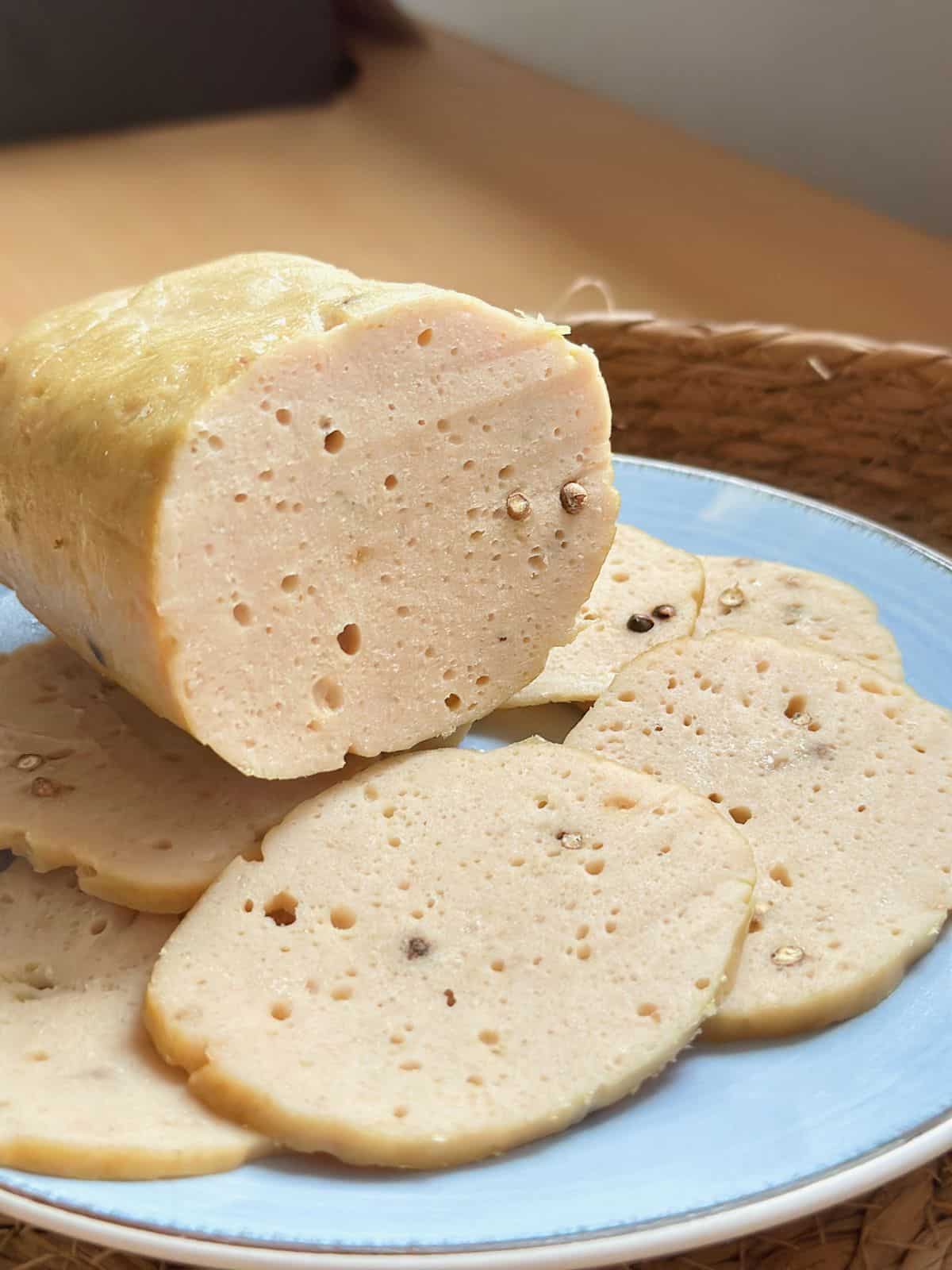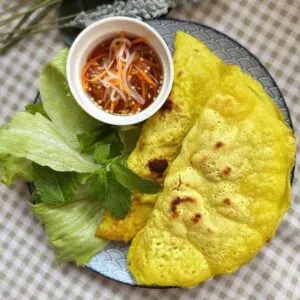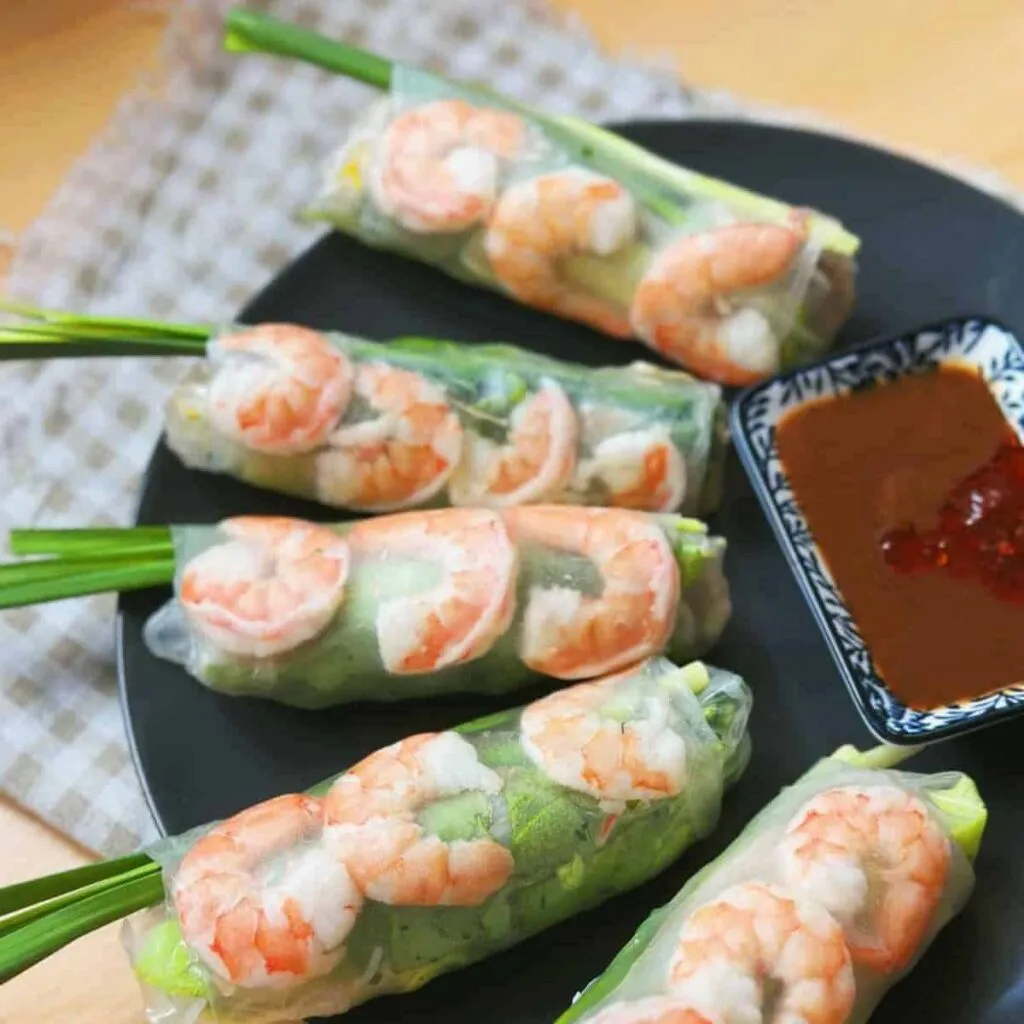Chả Lụa (a.k.a. Giò Lụa) is Vietnam’s beloved pork sausage – smooth, bouncy, and neatly wrapped in banana leaves before getting steamed or boiled to perfection.
And guess what? Making it at home is way easier than it looks. I pulled it off with just a small food processor! Plus, it’s cheaper and way cleaner than those store-bought rolls loaded with fillers.

What is Chả Lụa?
Meet Chả Lụa – the silky-smooth OG of Vietnamese sausages. In Vietnam, “Giò Chả” is the catchall for our sausage family, and “Lụa” literally means “silk,” because this sausage is as smooth as it gets. Down South, we call it Chả Lụa; up North, it’s Giò Lụa – or just Giò if you’re feeling lazy.
This beauty is everywhere in Vietnamese cuisine. You’ll spot it in sticky rice breakfasts, party platters, and of course, the iconic Saigon-style Bánh Mì – where it hangs out with liver pâté, creamy Vietnamese mayo, and tangy Đồ Chua (pickled carrots and daikon).

The “Giò Chả” crew – meet the lineup:
- Chả Chiên/Chả Mỡ: Fried, golden, and melt-in-your-mouth rich thanks to pork fat.
- Chả Quế: Pork meets cinnamon – unexpectedly perfect.
- Chả Cốm: Pork patties studded with young green rice, a Bún Đậu Mắm Tôm classic.
- Chả Cá: Vietnamese fish cake – totally different from Hanoi’s Chả Cá Lã Vọng (that famous turmeric fish with dill).
- Giò Sống: The raw pork paste that transforms into Chả Lụa – also a go-to base for soups like Canh Bí Đỏ (pumpkin), Cảnh Khổ Qua (bitter melon), or Bún Mọc (meatball noodle soup).
Plus, there are “textural cousins” like Nem Nướng (grilled pork skewers), Chạo Tôm (shrimp on sugarcane), and Bò Viên (the bouncy beef meatballs floating in your Phở bowl).
Ingredients

- Pork & Chicken Breast: Want that pale, silky white color like the store-bought kind? Go for pork loin instead of fatty pork butt. A sneaky trick I learned from a Hanoi home cook – toss in a bit of chicken breast or tenderloin for an even lighter color and smoother texture.

- Fish Sauce: Non-negotiable for authentic flavor. Use the good stuff – cheap fish sauce just won’t cut it.
- Starch: Cornstarch, tapioca, or potato starch all work, but potato starch gives the bounciest results.
- Baking Powder: Single-acting only! In Europe, that’s standard (hello, Dr. Oetker or Alsa). In the U.S., you’ll want to look for these brands to nail the texture.
- Sugar: Southern-style Chả Lụa is a little sweeter, and my recipe leans that way.
- Cooking Oil or Fat: Pork fat is king in Vietnam, but regular oil works if you’re keeping it lighter.
- Garlic or Onion Powder: A quick way to add aroma. Fresh garlic or shallots? Totally fine, too.
- Peppercorns: I go heavy because I love that spicy kick – you do you.
- Chicken Powder: Adds an extra layer of umami magic.
- Water: The secret to that soft, springy “silk” texture. If yours turns out dry, you probably skimped here.
- Banana Leaves & Aluminum Foil: Your wrapping dream team.
Instructions
Marinate the meat
- Slice the pork and chicken into thin strips. (Using a stand mixer later? Grind the meat now.)
- Mix the pork and chicken with all the seasonings except for the peppercorns.
- Spread the mixture evenly in a freezer-safe Ziploc bag, creating a thin layer about 0.4 inches (1 cm) thick.
- Pop the bag into the freezer for 3–4 hours until it hits the partially frozen state (icy-cold but slightly thawed on the surface). No time to make Chả Lụa today? No worries—leave it in the freezer and thaw at room temperature for 1–1.5 hours before using.
- Before grinding, cut the frozen meat slab into smaller pieces with scissors or a knife.



Using a Food Processor
Perfect for small batches (0.4–0.7 lbs or 200–300 g, tested on my 800W processor).
For bigger amounts, split the meat into 2–3 batches.
- Pulse at the lowest setting for 2–3 pulses, scrape the sides, and push the meat toward the blades.
- After about 10 pulses, switch to high speed for 7–10 seconds, scraping occasionally.
- Toss in the peppercorns if you like a little bite.
The paste is ready when it’s smooth, pale, and fluffy—it should stick to a spoon when scooped.
Transfer to a bowl and repeat until all batches are done. Then return all the pork paste to the Ziploc bag and slam it (yes, really!) onto the counter or stovetop about 50 times. This step gives Chả Lụa its signature springy texture.



Using a Stand Mixer
This method works for larger batches (1.1 lbs or 500 g). Use the flat beater attachment and start with ground pork (store-bought or homemade).
- Beat on low for 2 minutes.
- Increase to medium and continue for 3–5 minutes.
- Finish on high for another 3–5 minutes. Add the peppercorns here.
Your pork paste is ready when it’s pale, smooth, and sticks to a spoon.
Shape & Wrap
- Thaw the banana leaves, wash, rinse, and pat them dry.
- On a sheet of aluminum foil (twice the size of your banana leaf), place the leaf, then spoon the pork paste into the center.
- Wet your hands and shape it into a log, pressing out any air pockets. Cover with another banana leaf and fold the sides inward. Wrap tightly with aluminum foil to hold its shape.



Steam
Since we’re using foil (and don’t want soggy Chả Lụa), steaming is the way to go.
- Steam the roll for 45–50 minutes, then let it cool completely.
- Store in the fridge for up to 1 week, or freeze for up to 1 month.


Tips for Chả Lụa Success

- Start with super-fresh meat. The fresher, the better! Check those expiry dates and grab the newest cut you can find – quality meat is everything here.
- Keep it cold – always. A chilled mix is the secret to that bouncy, springy texture thanks to protein extraction, which works best at 39°F–44°F (4°C–7°C).
- Use a thermometer if you can. If your pork paste creeps past 41°F (5°C), take a break – pop the bowl in the fridge for 20–30 minutes to chill it back down.
- Don’t overload your machine. Small food processor? Stick to 0.4–0.7 lbs (200–300 g) per batch. Stand mixer? 1.1 lbs (500 g) is your sweet spot.
- Keep that bowl frosty. You should see condensation on the outside. No condensation = stop! Chill the bowl and meat for 30 minutes before continuing.
What to Serve with Chả Lụa
Chả Lụa is the ultimate multitasker of Vietnamese cuisine. Snack on it straight, slice it up as a side, toss it on top of noodles, or make it the star of the show – it just works.
FAQs
More authentic Vietnamese recipes

Chả Lụa/Giò Lụa (Vietnamese Pork Roll/Vietnamese Ham)
Equipment
- 1 Food Processor (or 1 stand mixer with the flat beater attachment)
Ingredients
- 0.9 pound pork loin (400g)
- 0.2 pound chicken breast / chicken tender (100g) (you can use pork)
- 1 tbsp Red Boat fish sauce
- 1½ tsp chicken powder
- 2 tsp sugar
- 1 tbsp potato starch (or tapioca starch, cornstarch)
- 3 tbsp cooking oil
- 1 tsp baking powder (read my note at the end)
- 5 tbsp water
- ½ tbsp garlic powder (or onion powder)
- ½ tbsp peppercorns (to your taste)
- Banana leaves
- Aluminum foil
Instructions
Marinate the meat
- Cut the pork and chicken into thin strips. If you're using a stand mixer to beat the meat, you'll have to grind it at this stage.
- Marinate the meat with all the other ingredients (except for the peppercorns).
- Put the mixture into a freezer-safe Ziploc bag and spread it evenly to create a layer about 0.4 inches (1 cm) thick.
- Put this bag in the freezer and leave it for 3-4 hours until it's partially frozen. If you're unable to make it within a day, simply keep it in the freezer. When you're ready to cook, let it sit at room temperature for 1-1.5 hours until it thaws to a partially frozen state.
- Before processing the meat, cut the partially frozen mixture into smaller pieces with scissors or a knife.
With a food processor (for a small batch 0.4-0.7 pounds or 200-300 grams)
- For larger batches, divide the meat mixture into 2 or 3 portions.
- Begin by pulsing the meat mixture at the lowest power setting. After 2-3 pulses, scrape down the sides of the work bowl and push any remaining meat into the blades.
- After pulsing about 10 times, you can increase the speed to high for 7-10 seconds. Don't forget to stir the meat occasionally and scrape down the sides of the bowl. Add the peppercorns if you like.
- The paste is ready when it reaches a smooth, paler, and fluffy texture. When using a spoon to scoop the paste, it should stick to the spoon.
- Transfer this pork paste to a bowl and continute with the second batch until all the meat is finished.
- Return all of the pork paste to the ziploc bag. Drop the bag containing the pork paste onto the stovetop about 50 times. This step will help to give a springy texture to your Chả Lụa.Another option is to use a hand mixer with dough hooks, beating the mixture for one minute. Remember to work with only 0.4-0.7 pounds (200-300 grams) at a time.
With a stand mixer (for a larger batch 1.1 pounds or 500 grams)
- Pound the mixture with the lowest speed for 2 minutes.
- Increase the speed to medium and continue beating for about 3-5 minutes.
- Finally, switch to the highest setting and beat for another 3-5 minutes while adding peppercorns.
- The paste is done when it looks smooth, paler, and fluffy, and sticks to the spoon when scooped.
Wrap and Roll
- Defrost the banana leaves, then wash, rinse, and pat dry them.
- Place a banana leaf on a piece of aluminum foil (twice the size of the leaf) and place the pork paste in the center.
- With damp hands, mold the pork paste into a log shape, ensuring there are no air pockets.
- Cover the log with another banana leaf, folding the sides to enclose the roll securely.
- Wrap the pork roll tightly with aluminum foil to retain its shape throughout cooking.
Steam the roll
- Place the pork roll in a steamer and steam for 45-50 minutes.
- Once cooked, allow it to cool completely. You can store it in the refrigerator for up to one week or in the freezer for up to a month.
Notes
- Use fresh meat with the longest expiry date.
- Check the meat’s temperature with a thermometer (if you have). If it exceeds 41°F (5°C), refrigerate for 20-30 minutes before proceeding.
- Avoid overloading your food processor or stand mixer.
- Keep the work bowl cold. If you don’t notice condensation forming on the outside of your work bowl, pause immediately. Place the bowl (with the meat) in the fridge for 30 minutes before working with it again.
- Baking powder: For this recipe, you’ll need single-acting baking powder. European brands such as Dr. Oetker (Germany) or Alsa (France) are good choices if you’re in the U.S.





Love it, with watercress, bok choy, etc
Thank you !! =)